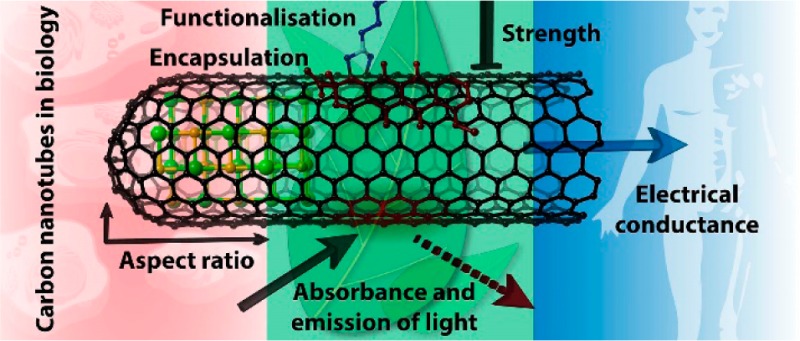- Record: found
- Abstract: found
- Article: not found
Can Carbon Nanotubes Deliver on Their Promise in Biology? Harnessing Unique Properties for Unparalleled Applications

Read this article at
Abstract

Carbon nanotubes (CNTs) are cylindrical sheets of hexagonally ordered carbon atoms, giving tubes with diameters on the order of a few nanometers and lengths typically in the micrometer range. They may be single- or multiwalled (SWCNTs and MWCNTs respectively). Since the seminal report of their synthesis in 1991, CNTs have fascinated scientists of all stripes. Physicists have been intrigued by their electrical, thermal, and vibrational potential. Materials scientists have worked on integrating them into ultrastrong composites and electronic devices, while chemists have been fascinated by the effects of curvature on reactivity and have developed new synthesis and purification techniques. However, to date no large-scale, real-life biotechnological CNT breakthrough has been industrially adopted and it is proving difficult to justify taking these materials forward into the clinic. We believe that these challenges are not the end of the story, but that a viable carbon nanotube biotechnology is one in which the unique properties of nanotubes bring about an effect that would be otherwise impossible. In this Outlook, we therefore seek to reframe the field by highlighting those biological applications in which the singular properties of CNTs provide some entirely new activity or biological effect as a pointer to “what could be”.
Abstract
Carbon nanotubes display many unique properties of potential value in biology and medicine, yet few are close to realization. We assess the potential for nanotubes to yield unprecedented new applications through interface with life.
Related collections
Most cited references58
- Record: found
- Abstract: found
- Article: not found
Carbon nanotubes: present and future commercial applications.
- Record: found
- Abstract: found
- Article: not found
Plant nanobionics approach to augment photosynthesis and biochemical sensing.
- Record: found
- Abstract: found
- Article: not found
